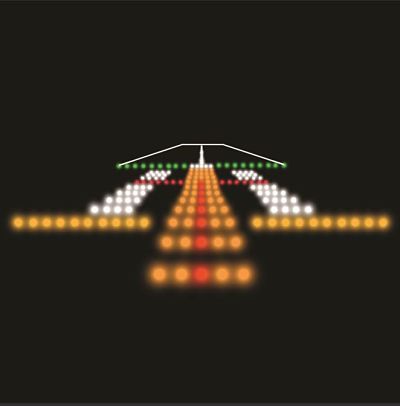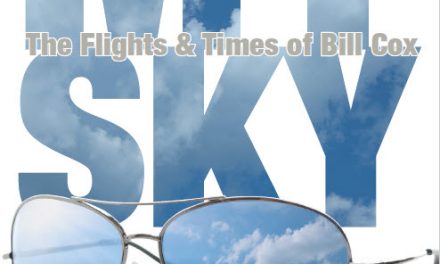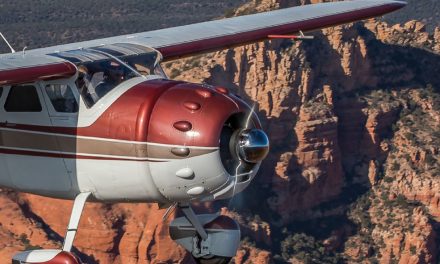Night flying can be profitable.
Back in the day when I was young and stupid, long before I discovered I could make even less money in aviation, I was determined to become one of the world’s great trumpet players. To that end, I studied with one of Hollywood’s hardest-working studio lead trumpets, Bud Brisbois. After a stint with Stan Kenton, Bud was working regularly with Henry Mancini, playing gigs all over the US.
Mancini was in great demand at cities with symphony orchestras that wanted to conduct a program of his music. Like many musicians, Mancini didn’t enjoy being on the road, and he accepted the dates on condition that he be flown in by corporate jet with four of his favorite soloists; typically, Bud on trumpet, Bud Shank on sax, Shelley Mann on drums and — I think — Milt Bernhart on trombone.
The musicians would typically depart in one of Clay Lacy’s Learjet 35s early on a Saturday morning, arrive in Kansas City, Dallas or New Orleans in time for a rehearsal, play the gig and fly home immediately after the concert. Bud said they were always treated like royalty, made great money and he was usually back at his home in Encino by 2:00AM Sunday morning. Bud wasn’t a pilot and didn’t know much about airplanes, but he always felt that was one of the great fringe benefits of working with Mancini, even if he did have to fly in the middle of the night.
The beauty of the night
Under some circumstances, night can be an enjoyable time to fly. We may not all fly Learjets halfway across the country in the dark, but night can still be a seductress. The weather is usually better, the temperature improves aircraft performance, the air can be almost glycerin smooth and — as the haze of the day settles out, the visibility becomes so good — you could see Hawaii if the Earth was flat.
Less than a dozen years after earning my license, I began ferrying airplanes internationally, and nearly all my first 40 trips across the North Atlantic from Canada nonstop to Ireland were at night. The time change between Gander, Newfoundland, and Shannon, Ireland is three hours, so if we departed at, say, 6 p.m. (9 p.m. in Ireland), we’d be landing sometime in early morning in Shannon after a 9- to 11-hour flight.
In those days, I was taught that night was the best time to fly the ocean. Weather was usually better, HF signals carried further, the airplane was happier, and as pilots we got to take 36 hours off rather than 24 in Ireland. If the worst did happen and we had to ditch, an emergency strobe could be visible for 30-40 miles — provided you survived the landing, got your raft deployed, succeeded in climbing aboard, didn’t suffer hypothermia or get eaten by sharks.
I’ve since learned better, but there’s no question night has its attractions — and its detractions. There’s less traffic and more visibility, no glare from the sun, instrument scanning is easier with well-illuminated dials, cities stand out from surrounding terrain, and airports and traffic are easier to locate with their telltale beacons.
I don’t do many Atlantic crossings — my West Coast domicile favors Pacific trips — but I still do my share of night flying, primarily because it’s often difficult to get everything done in daylight. Why sleep when you could be flying? Yes, I know. That attitude can get some pilots into trouble, and it does exactly that every year. Accident statistics suggest that flying by night accounts for about 10 percent of the general aviation accidents, but 30 percent of the fatalities. That suggests night flying must be inherently more dangerous than aviating when the sun is up.
The rules for night flying are more stringent in many countries than they are in the U.S., apparently in recognition of an increased level of risk. In Mexico, all night flights must be conducted IFR. Several African countries forbid ANY general aviation flights at night — airlines aren’t so constrained. Of course, just as with flying over water, the airplane doesn’t know it’s dark, so the problems of night flying are more related to pilots than airplanes. Here’s a short list of considerations for flying at night.
Flight planning and preflight
Many experienced pilots accept night flying as the same as daytime operation, but they shouldn’t. The differences begin with route planning before the flight.
1) Smart aviators may plan a slightly different route at night, one that takes advantage of available airports en route. There’s no logical reason for more mechanical malfunctions at night, but any problem may be compounded by the difficulty of executing emergency checklists and spotting reasonable landing sites. Accordingly, many pilots will plot a course that zig-zags between airports rather than simply punching “Go To” on the Garmin and flying GPS-direct. The distance will be slightly greater, but not as much as you might imagine. For fans of pilotage, the old trick of picking a prominent point on the far horizon, flying to it and picking another and then another may be a challenge when you can’t see a horizon.
2) Many pilots plan for a higher cruising altitude at night, simply because suitable emergency landing sites may be fewer and farther between. The difference between cruise at 8,500 and 10,500 feet may not seem like much until you have to glide back to Earth at 800-900 fpm without power. That extra 2,000 feet represents an additional two plus minutes of time to make important decisions.
3) Just as you’ll want to consider flight planning for alternate airports and climbing higher to prolong glide, you should allow more generous fuel reserves at night. It’s easier to become disoriented in the dark, so there’s a slightly higher risk of “temporary disorientation,” as the military calls it. We call it lost. Also, pilots flying at night have a greater sense of get-there-itis, and that may mean decisions they wouldn’t make in daylight when things are actually visible. Even if the problem is only one of being a little short on fuel and needing to stop for a few gallons, not every airport offers fuel sales in the wee small hours. That can encourage dumb decisions.
4) If you haven’t looked at a chart in years — raise your hands — a night flight might be a good time to actually mark a course line on a WAC or sectional chart. Consider using a wide point pencil or pen, perhaps even a Sharpie, for your flight track line and flight log. Don’t use a highlighter as the color may appear as a solid black line under red light.
5) You’ll obviously need a flashlight or two for the preflight. I use a hands-free miner’s light or camp light that straps to my forehead and shines wherever I’m looking, plus two or three Maglights of various sizes for other tasks. To keep pens, flashlights and other important stuff where I can find it, I use industrial strength Velcro.
6) Checking for fuel contamination can be a challenge at night, so I hold the sample against a white surface and shine a light through the cup from the side. That allows me to see any crud at the bottom of the cup.
7) Keep in mind that your eyes demand more oxygen than the rest of your body as you climb away from Earth into thinner air. For that reason, you might consider using supplemental O2 on any flight above 5,000 feet. If you live in Denver or Albuquerque, your body has probably adapted to the reduced atmospheric pressure, and you have a natural advantage over the rest of us. Also, remember the story of the two families that live in your eyes, the rods and the cones. The rods live in the center of your eyes and need plenty of light to see. The cones are more sensitive souls who live in the suburbs, so they can see things the insensitive rods can’t. In other words, if you’re looking for a beacon at night, use your peripheral vision.
Takeoff and climb
8) When it comes time to actually commit aviation, use aircraft lighting to warn others that you’re coming — up to a point. Years ago, a not-so-grizzled but well-experienced instructor suggested leaving the rotating beacon switch on all the time, so it would come on with the master. Prior to start, this suggests to any and all that you’re about to do something serious, or just did. Be a little more judicious with the landing/taxi light and strobe. If you’re using position lights and rotating beacon, that may be plenty on the ground. It might be best to save the landing light for the lights/camera/action check as you take the runway.
9) Unless you have excellent visibility and there’s a bright moon overhead, it’s probably best to make a semi-instrument departure, regardless of how you’ve filed, especially if the departure path crosses unlighted territory — the dreaded black-hole departure. Double check that your altimeter is set for field elevation before takeoff and note any error. Keep a close eye on the altitude, airspeed and ADI during the initial ascent.
10) After the liftoff and 500 feet of climb at Vy, it’s probably best to lower the nose for a cruise climb to improve forward visibility and let you see the strobes of all traffic ahead. If you have any form of traffic alert — TIS or TCAS — have it displayed before takeoff in case someone forgot to turn on their strobes.
En route
11) In some respects, night flight flies in the face of human habits. Our circadian rhythm clues our bodies that night is the time to sleep, and unless the trip is a short one, the — hopefully — monotonous drone of the engine, comfortable warmth of the heater and gentle vibration of the airframe may make us drowsy. For that reason, pilot currency is all the more critical. Pilots familiar with the syndrome are more likely to make a wise decision, but others may need to recognize their own incapacity, land short, get some rest and continue the trip in daylight.
12) Trouble is, everything about night flying inclines us to do the opposite. Fuel exhaustion may be more common at night, because the consequences of an extra stop — lack of available fuel, landing at an unfamiliar airport in the dark, the expense and inconvenience of an extra night on the road — may incline us to go for it rather than take the conservative approach. In daylight, we can see the mountains, highways, rivers and lakes sliding by below in predictable patterns. At night, especially when operating over patches of black Earth, there may be almost no perception of speed, and any night cross-countries may seem to take forever. There’s a certain get-home-itis that sometimes afflicts pilots at night. If the speed of light is very fast, the speed of dark (night?) can seem very slow.
13) Though cities, airports, antennas and other traffic stand out at night, clouds don’t. They usually dissolve to invisibility. That’s another reason to fly higher. Though the haze of the day tends to settle out at night, clouds may linger stubbornly along your route. Even xenon landing lights suitable for a Baja 1000 truck won’t help you spot clouds ahead.
14) It’s a good idea at night to ask for flight following, both to keep you awake and to provide an assist in “seeing” other traffic. A controller may also advise about weather and restricted areas and direct you toward an airport if things go wrong.
15) An engine failure at night isn’t any more likely than in daytime, but there are few hard and fast rules for handling one. Forced landings take on a whole new level of difficulty when you can’t see where you’re landing. The old joke used to be; if the engine quits and you’re forced to land into a black hole, turn on the landing light for the flare. If you don’t like what you see, turn it off. These days, GPS’s nearest airport function has relegated the problem of finding the ground academic, since you can interrogate the system to learn the exact elevation at any point. If you did your preflight preparation correctly, you should know what local ground elevation is below. Most experienced night pilots agree the smartest idea is to fly toward something as bright as possible, so you can at least see what you’re about to hit.
16) If well-lit areas such as cities appear to blink, or suddenly disappear completely, beware. There may be something in between you and the lights that you can’t see, clouds, an antenna or, worst of all, big rocks.
Approach and landing
17) Altimeter settings become more critical when the ground may be invisible, and you should take every opportunity to update yours, factoring in any necessary corrections. Every pilot knows it’s especially important to update the altimeter as you approach the destination, but it’s critical over a boondock airport with minimum lights.
18) Consider using square patterns at night with a relatively wide base to give you plenty of time to judge the final turn and the landing approach. Leave the constant-turn, carrier-style approaches to the Marines. Square turns and a longer, higher final provide a hedge for judging your approach path. If there’s no ILS but there are VASI or PAPI lights, use them. They’re a good visual representation of a three-degree glide. Remember that a standard glideslope is 300 feet/nm, so if you have GPS or DME on board, you can construct your own manual glideslope — 1,500 feet at five miles, 900 feet at three miles and 300 feet at one mile.
19) If there’s haze in the air and the airport lights are in sight but only barely, you can either ask the controller to go to high intensity or click the mic five, seven or nine times — after hours or at some uncontrolled airports — to boost the brightness.
20) Finally, if conditions are IFR and near minimums, avoid the temptation to duck under. You may start seeing lights through the bottom of the overcast as you descend, something you might not see in daytime, but you need to have a clear view of the runway lights at minimums to complete the approach. Duck under even once, and you may discover the real meaning of the phrase, “What a difference a day makes.”






